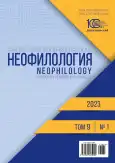Fake information markers in COVID-19 news
- Authors: Bitkova V.V.1
-
Affiliations:
- Ural Federal University named after the first President of Russia B.N. Yeltsin
- Issue: Vol 9, No 1 (2023)
- Pages: 173-185
- Section: MEDIA COMMUNICATIONS AND JOURNALISM
- URL: https://journal-vniispk.ru/2587-6953/article/view/295691
- DOI: https://doi.org/10.20310/2587-6953-2023-9-1-173-185
- ID: 295691
Cite item
Full Text
Abstract
The relevance of the study is due to the interest of modern linguistics in the phenomenon of fake, the need for its comprehensive understanding and description. The aim of the work is to study the spread of fake information in the context of the COVID-19 pandemic, as well as to create a classification of fake information markers based on the study of I.A. Sternin and A.M. Shesterina. For the analysis of fakes, the database “Fake News in Social Networks and Media” was created, the material was 252 Internet texts containing false statements about COVID-19 from January 2020 to February 2022. Texts were collected using a continuous sampling method, sources for collecting material served as social networks and media sites. All fragments are divided into six groups by content: “Vaccination” (32 %), “Conspiracy Theories” (20 %), “International News” (18 %), “Panic Reports and Warnings” (14 %), “Pseudo-medical advice” (9 %), “Reports of confirmed cases/deaths” (7 %). In addition, the distribution of fakes in each year is considered. In the above fragments of fakes, the following groups of typical markers of fake information were identified: Formal markers, Content markers, Lexical markers, Pragmatic markers, Information sources, Argumentation. Examples from the database are selected for each marker.
About the authors
V. V. Bitkova
Ural Federal University named after the first President of Russia B.N. Yeltsin
Author for correspondence.
Email: lera.bitkova2016@gmail.com
ORCID iD: 0000-0002-3144-9607
laboratory researcher of the Research and Education Center “Digital Humanities”
19 Mira St., Yekaterinburg, 620002, Russian FederationReferences
- Allcott H., Gentzkow M. Social media and fake news in the 2016 election. Journal of Economic Perspectives, 2017, vol. 31 (2), pp. 211-236. https://doi.org/10.1257/jep.31.2.211
- Lazer D.M., Baum M.A., Benkler Y. The science of fake news. Science, 2018, vol. 359 (6380), pp. 1094-1096. https://doi.org/10.1126/science.aao2998
- Tandoc Jr. E.C., Lim Z.W., Ling R. Defining “Fake News”. Digital Journalism, 2018, vol. 6 (2), pp. 137-153. https://doi.org/10.1080/21670811.2017.1360143
- Tandoc Jr. E.C., Thomas R.J., Bishop L. What is (Fake) News? Analyzing News Values (and More) in Fake Stories. Media and Communication, 2021, vol. 9 (1), pp. 110-119. https://doi.org/10.17645/mac.v9i1.3331
- Vosoughi S., Roy D., Aral S. The Spread of True and False News Online. Science, 2018, vol. 359 (6380), pp. 1146-1151. https://doi.org/10.1126/science.aap9559
- Egelhofer J.L., Lecheler S. Fake news as a two-dimensional phenomenon: a framework and research agenda. Annals of the International Communication Association, 2019, vol. 43 (2), pp. 97-116. https://doi.org/10.1080/23808985.2019.1602782
- Karasik V.I. Factoids as a linguocultural phenomenon. Politicheskaya lingvistika = Political Linguistics, 2017, no. 3 (63), pp. 21-30. (In Russ.) https://elibrary.ru/zdmbfx
- Zuikina K.L., Sokolova D.V. Content specifics of Russian fake news on the internet and on television. Vestnik Moskovskogo universiteta. Seriya 10: Zhurnalistika [Bulletin of Moscow University. Series 10: Journalism], 2019, no. 4, pp. 3-22. (In Russ.) https://doi.org/10.30547/vestnik.journ.4.2019.322, https://elibrary.ru/xccerj
- Molina M.D., Sundar S.S., Le D. “Fake News” Is Not Simply False Information: A Concept Explication and Taxonomy of Online Content. American Behavioral Scientist, 2021, vol. 65 (2), pp. 180-212. https://doi.org/10.1177/0002764219878224
- Bakir V., McStay A. Fake news and the economy of emotions. Digital Journalism, 2018, vol. 6 (2), pp. 154-175. https://doi.org/10.1080/21670811.2017.1345645
- Martel C., Pennycook G., Rand D.G. Reliance on emotion promotes belief in fake news. Cognitive Research Principles and Implications, 2020, vol. 5 (1), p. 47. https://doi.org/10.1186/s41235-020-00252-3
- Heath C. Do People Prefer to Pass along Good or Bad News? Valence and Relevance of News as Predictors of Transmission Propensity. Organizational Behavior and Human Decision Processes, 1996, vol. 68 (2), pp. 79-94. https://doi.org/10.1006/obhd.1996.0091
- Vorderer P., Klimmt C., Ritterfeld U. Enjoyment: At the Heart of Media Entertainment. Communication Theory, 2004, vol. 14 (4), pp. 388-408. https://doi.org/10.1111/j.1468-2885.2004.tb00321.x
- Duffy A., Tandoc E., Ling R. Too Good to Be True, Too Good Not to Share: The Social Utility of Fake News. Information, Communication & Society, 2019, vol. 23 (13), pp. 1-15. https://doi.org/10.1080/1369118X.2019.1623904
- Bright J. The Social News Gap: How News Reading and News Sharing Diverge. Journal of Communication, 2016, vol. 66 (3), pp. 343-365. https://doi.org/10.1111/jcom.12232
- Marwick A.E. Why Do People Share Fake News? A Sociotechnical Model of Media Effects. Georgetown Law Technology Review, 2018, vol. 2 (474), pp. 474-512. Available at: https://georgetownlaw-techreview.org/wp-content/uploads/2018/07/2.2-Marwick-pp-474-512.pdf
- Sukhodolov A.P., Bychkova A.M. Fake news as a modern media phenomenon: definition, types, role of fake news and ways of taking measures against it. Voprosy teorii i praktiki zhurnalistiki = Theoretical and Practical Issues of Journalism, 2017, vol. 6, no. 2, pp. 143-169. (In Russ.) https://doi.org/10.17150/2308-6203.2017.6(2).143-169, https://elibrary.ru/xsetyb
- Arkhipova A.S., Radchenko D.A., Kozlova I.V., Peigin B.S., Gavrilova M.V., Petrov N.V. Specifics of infodemic in Russia: from WhatsApp to the Investigative Committee. Monitoring obshchestvennogo mneniya: ehkono-micheskie i sotsial'nye peremeny = Monitoring of Public Opinion: Economic and Social Changes, 2020, no. 6 (160), pp. 231-265. (In Russ.) https://doi.org/10.14515/monitoring.2020.6.1778, https://elibrary.ru/gwigpr
- Sternin I.A., Shesterina A.M. Markery feika v mediatekstakh [Markers of fake in media texts]. Voronezh: LLC “Publisher RITM”, 2021, 60 p. (In Russ.) Available at: https://www.vsu.ru/ru/university/structu-re/communicate/pdf/monographs/markers2.pdf
- Panchenko N.N. Feik-novost' v aspekte dostovernosti [Fake news in terms of reliability]. Teoreticheskie i prik-ladnye aspekty izucheniya rechevoi deyatel'nosti = Theoretical and Applied Aspects of Studying Speech Activity, 2013, vol. 8, no. 1, pp. 164-169. (In Russ.) https://elibrary.ru/qcdasf
- Brennen J.S., Simon F.M., Nielsen R.K. Beyond (Mis)Representation: Visuals in COVID-19 Misinformation. The International Journal of Press/Politics, 2021, vol. 6 (1), pp. 277-299. https://doi.org/10.1177/1940161220964780
Supplementary files










